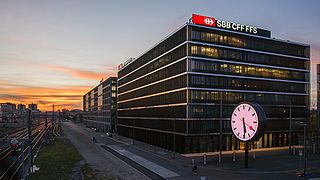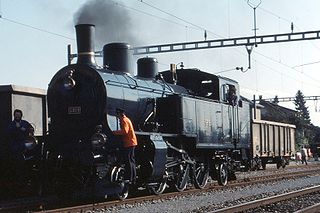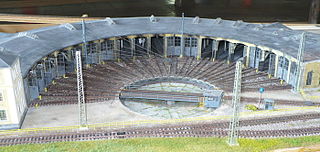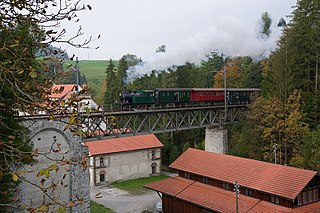
A heritage railway or heritage railroad is a railway operated as living history to re-create or preserve railway scenes of the past. Heritage railways are often old railway lines preserved in a state depicting a period in the history of rail transport.

The National Railway Museum (NRM) is a museum in York, England, forming part of the Science Museum Group. The museum tells the story of rail transport in Britain and its impact on society. It is the home of the national collection of historically significant railway vehicles such as Mallard, Stirling Single, Duchess of Hamilton and a Japanese bullet train. In addition, the National Railway Museum holds a diverse collection of other objects, from a household recipe book used in George Stephenson's house to film showing a "never-stop railway" developed for the British Empire Exhibition. It has won many awards, including the European Museum of the Year Award in 2001.

Swiss Federal Railways is the national railway company of Switzerland.

Mangapps Railway Museum is a heritage railway centre located near Burnham-on-Crouch in Essex, England. The 0.75 miles (1.2 km) of standard gauge running line and museum are owned and operated by the Jolly family assisted by volunteers.

The Ae 6/6 is a heavy electric locomotive used by the Swiss Federal Railways (SBB). It is sometimes also referred to as "canton locomotive", because the first 25 locomotives were named after the cantons of Switzerland and carried the canton's coat of arms on the side and chrome embellishments, and the Swiss coat of arms on the front, between the chrome stripes. These adornments made them internationally famous. The other 95 (94) locomotives received the names of capital cities of Swiss cantons, and other towns and cities, but without the chrome embellishments. The namings were held as ceremonies in the respective cities. A less flattering moniker is Schienenwolf as the three axle bogie construction stresses the tracks heavily.

The Re 420, originally and still widely called Re 4/4II, are a series of versatile standard gauge electric locomotives of Swiss Federal Railways, but are also used by BLS AG and private companies. They were produced over a period of 21 years, from 1964 to 1985, and are currently used mainly for freight operations but still also for some push-pull passenger train services. It is the largest series of locomotives of Swiss Federal Railways and they are the most common type of locomotive in Switzerland.

The Valley Heights Rail Museum is a railway museum located in Valley Heights, New South Wales, Australia. The facility is located 400 metres (1,300 ft) north-west of Valley Heights railway station. The museum is operated by two partner organisations:

For more than a century, the Swiss locomotive, multiple unit, motor coach and railcar classification system, in either its original or updated forms, has been used to name and classify the rolling stock operated on the railways of Switzerland. It started out as a uniform system for the classification and naming of all rolling stock, powered and unpowered, but had been replaced and amended by the UIC classification of goods wagons.

The Freilassing Locomotive World is a railway museum in the Berchtesgadener Land, which is operated with the cooperation of the town of Freilassing and the Deutsches Museum. The museum is located on the site of the former Freilassing locomotive shed which belongs to the Deutsche Bahn AG and houses part of the Deutsches Museum's railway collection. The second part of the collection is in the transport centre of the Deutsches Museum on the Theresienhöhe in Munich.

The Bözberg railway line is a railway line in Switzerland, running between Basel and Brugg via Pratteln, Rheinfelden, Stein-Säckingen, Frick and the Bözberg Tunnel. At Brugg it connects to Zürich via Baden and to the Gotthard Railway via the Aargauische Südbahn.

The Swiss Class A 3/5 locomotives were built between 1902 and 1922 for the Jura–Simplon Railway, and the Gotthard Railway. These railways were absorbed into Swiss Federal Railways in 1903. In total 111 4-6-0 locomotives of this type were built by Schweizerische Lokomotiv- und Maschinenfabrik in Winterthur, Switzerland.

The C 5/6 were a class of steam locomotives in use for the Swiss Federal Railways. 28 of them were built between 1913 and 1917; all had been withdrawn by 1968. Four have been preserved, one of them in working order. The class was designed for use on the steep inclines of the Gotthard route, and was considered extremely efficient, earning the nickname Elephant. Its design was based on the successful C 4/5 locomotive, and the result is the largest steam locomotive operated by the Swiss Federal Railways. Within a few years of introduction, however, they began to be replaced by new electric locomotives.

The Re 450 is a push-pull electric locomotive of Swiss Federal Railways, which combined with passenger coaches is only used for commuter rail services of Zurich S-Bahn in the metropolitan area of Zurich. Under the old Swiss class system, they would have been known as Re 4/4V.

Brugg AG railway station serves the municipality of Brugg, in the canton of Aargau, Switzerland. Opened in 1856, it is owned and operated by Swiss Federal Railways.

The Dampfbahn-Verein Zürcher Oberland (DVZO), lit. 'steam train association of Zürcher Oberland', is a heritage railway association based in the Swiss canton of Zürich. It owns historic locomotives and coaches and operates railway services between the towns of Hinwil and Bauma most Sundays from May to October, in addition to charter services on the whole Swiss railway network.
The Ohai Railway Board Heritage Trust is a defunct railway preservation society that was formed to preserve Southland's rail history. The trust was formerly based at Wairio on the Wairio Branch in the former Ohai Railway Board workshops, and owned a number of locomotives and items of rolling stock, including the remains of two P class 2-8-0 tender locomotives.

The Huttwil–Wolhusen railway line is a single-track standard-gauge railway line in Switzerland and currently operated by BLS AG. It was built by the Huttwil-Wolhusen-Bahn (HWB), based in Willisau, and opened on 9 May 1895. Operations were managed by the Langenthal-Huttwil-Bahn (LHB), which owned and operated the Langenthal–Huttwil railway. On 1 January 1944, the HWB was merged into the Vereinigte Huttwil-Bahnen, which was later merged into BLS AG.

The Flamatt–Laupen–Gümmenen railway line is a line in Switzerland that was built and formerly operated by the Sense Valley Railway. The 11.5 km-long standard-gauge line on the Flamatt–Laupen–Gümmenen route through the Sense valley was opened on 20 January 1904. The shares of the company were acquired by the Swiss Federal Railways (SBB) and Swiss Post (34 %) in 2001. Since then, the infrastructure of the Sense Valley Railway has been operated by the SBB under contract.

The Tavannes–Noirmont railway line is a metre-gauge railway line in western Switzerland. The Tramelan-Tavannes Railway opened the first section in 1884; the Tramelan – Breuleux – Noirmont Railway completed the line between Tramelan and Le Noirmont in 1913. The line was electrified in 1913 and has belonged to the Chemins de fer du Jura (CJ) since 1944.

The Red Arrow is a class of 12 disparate but similar railcars built in the 1930s by the Swiss Federal Railways (SBB). As built there was a mixture of single and double units, and of diesel and electrically propelled units. They were originally intended for traffic on lines with a low volume of traffic, following the global economic crisis of 1928.




















